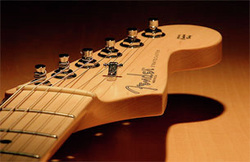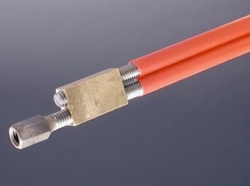Guitar Neck Relief

There are things that you want to know before you start. Many guitars have truss rods that are embedded in the guitar neck and this adjustable rod usually runs the full length of the neck.
Usually there is a channel that is routed down the center of the guitar neck that is situated directly below the fretboard. The truss rod is then loosely placed into the channel with the only attachment being at the opposite end of the truss adjustment nut.
Truss rods mostly are grouped into three different configurations:
Fixed Truss Rods:
Every so often the guitar luthier decided to use a fixed or rigid reinforcement - this is really not a truss rod at all. The steel configuration can be tube-shaped, a steel tee or steel rectangular bar stock. Whenever aluminum is used as the reinforcement medium you will usually find heat-tempered aluminum used for extra strength.
One Way Truss Rod:
Nearly all luthiers and guitar manufacturers will use a one-way adjustable rod, which allows you to only adjust the neck in one direction. If a backward bow position exists in the neck, you cannot adjust for this condition with a one-way truss rod.
Truss Rods with 2 Direction Adjustment:
Truss rods that are adjustable in both directions permit a great amount of versitility. When you apply tention to the rod the neck bows upward, and when the truss rod is loosened, the neck is bowed downwards. So you can basically adjust any neck status with the exclusion of a twisted neck.
Usually there is a channel that is routed down the center of the guitar neck that is situated directly below the fretboard. The truss rod is then loosely placed into the channel with the only attachment being at the opposite end of the truss adjustment nut.
Truss rods mostly are grouped into three different configurations:
Fixed Truss Rods:
Every so often the guitar luthier decided to use a fixed or rigid reinforcement - this is really not a truss rod at all. The steel configuration can be tube-shaped, a steel tee or steel rectangular bar stock. Whenever aluminum is used as the reinforcement medium you will usually find heat-tempered aluminum used for extra strength.
One Way Truss Rod:
Nearly all luthiers and guitar manufacturers will use a one-way adjustable rod, which allows you to only adjust the neck in one direction. If a backward bow position exists in the neck, you cannot adjust for this condition with a one-way truss rod.
Truss Rods with 2 Direction Adjustment:
Truss rods that are adjustable in both directions permit a great amount of versitility. When you apply tention to the rod the neck bows upward, and when the truss rod is loosened, the neck is bowed downwards. So you can basically adjust any neck status with the exclusion of a twisted neck.
Title.

Guitar 2-way Truss Rod
Guitar Neck Relief:
The term Guitar Neck Relief is the amount of bow that is present in a guitar neck. It can be a forward or backward bow.
The terms used to define neck relief are very puzzling. We term these conditions backward bow and forward bow.
Forward Bow:
You want a certain amount of forward bow in your guitar neck. At least a minor amount. If you think of forward bow as a gentle 'cupping' of the neck, it helps you visualize this condition much better.
To check this out, hold a string downwards tightly from the first fret to the twelfth fret and measure the distance from the sixth fret to the underside of the stretched string.This would be the guitar neck relief measurement.
Backward Bow:
Is a condition that you do not want - ever. If you have backward bow, you will have to have the strings on the guitar higher than usual to keep them from buzzing.
An adjustable truss rod is a perfect asset to have when you encounter this condition. Try the matching exercise you did for the forward bow condition. You will observe that the string does not clear the fret at the center of the neck and comes in contact with the frets.
Neck Relief - The Measurement:
There is a measurement that we desire to obtain when it comes to Guitar Neck Relief on our guitars. To begin the measurement procedure, tighten a guitar capo precisely behind the first fret. Do not put too much tension on the capo or the string may rise up slightly. To do a hands-free measurement, employ another capo at the 12th fret.
Your measurement should be made with a feeler gage from the top of the 6th fret to the bottom of the string. The measurement is desired to be between 0.010" and 0.015".
Don't become too overly concerned if your measurement is somewhat more than the high-end number. If you experience less than 0.010" investigate a truss rod adjustment to get your neck relief between acceptable tolarences.
Cautions:
The appropriate place to measure neck relief is in the center of the neck, that being between the nut and the twelfth fret. If you find that there is a bulge over the top plate of the guitar, you are dealing with another repair condition that cannot be addressed by a truss rod modification.
Tools Required for Measuring Neck Relief:
There are a few tools you will need to address the measurement of Guitar Neck Relief.
Adjusting for Desirable Neck Relief:
There are definitely some tips you will want to know about to adjust your Guitar Neck Relief.
Look for our article on How to Adjust a Truss Rod for more information.
The term Guitar Neck Relief is the amount of bow that is present in a guitar neck. It can be a forward or backward bow.
The terms used to define neck relief are very puzzling. We term these conditions backward bow and forward bow.
Forward Bow:
You want a certain amount of forward bow in your guitar neck. At least a minor amount. If you think of forward bow as a gentle 'cupping' of the neck, it helps you visualize this condition much better.
To check this out, hold a string downwards tightly from the first fret to the twelfth fret and measure the distance from the sixth fret to the underside of the stretched string.This would be the guitar neck relief measurement.
Backward Bow:
Is a condition that you do not want - ever. If you have backward bow, you will have to have the strings on the guitar higher than usual to keep them from buzzing.
An adjustable truss rod is a perfect asset to have when you encounter this condition. Try the matching exercise you did for the forward bow condition. You will observe that the string does not clear the fret at the center of the neck and comes in contact with the frets.
Neck Relief - The Measurement:
There is a measurement that we desire to obtain when it comes to Guitar Neck Relief on our guitars. To begin the measurement procedure, tighten a guitar capo precisely behind the first fret. Do not put too much tension on the capo or the string may rise up slightly. To do a hands-free measurement, employ another capo at the 12th fret.
Your measurement should be made with a feeler gage from the top of the 6th fret to the bottom of the string. The measurement is desired to be between 0.010" and 0.015".
Don't become too overly concerned if your measurement is somewhat more than the high-end number. If you experience less than 0.010" investigate a truss rod adjustment to get your neck relief between acceptable tolarences.
Cautions:
The appropriate place to measure neck relief is in the center of the neck, that being between the nut and the twelfth fret. If you find that there is a bulge over the top plate of the guitar, you are dealing with another repair condition that cannot be addressed by a truss rod modification.
Tools Required for Measuring Neck Relief:
There are a few tools you will need to address the measurement of Guitar Neck Relief.
- Feeler Gage;
- Steel Ruler in Decimal Inches or Millimeters;
- (2) Guitar Capos
Adjusting for Desirable Neck Relief:
There are definitely some tips you will want to know about to adjust your Guitar Neck Relief.
Look for our article on How to Adjust a Truss Rod for more information.
